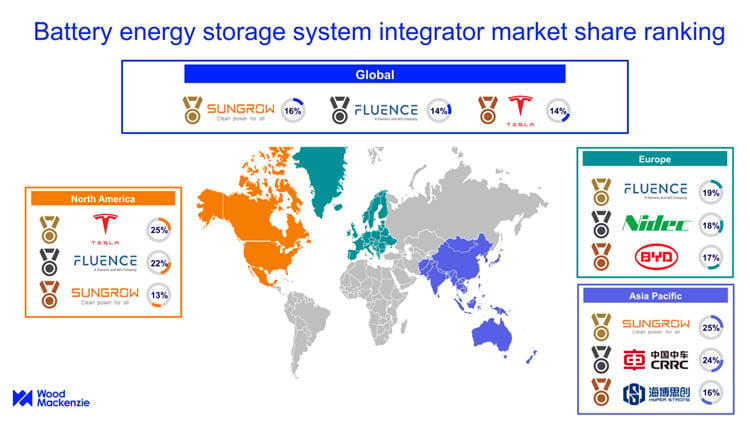Report on European Union’s Progress in Renewable Energy and Storage in Alignment with Sustainable Development Goals
Advancing SDG 7 (Affordable and Clean Energy) and SDG 13 (Climate Action)
The European Union (EU) is making significant strides towards achieving key Sustainable Development Goals, particularly SDG 7 (Affordable and Clean Energy) and SDG 13 (Climate Action), through its ambitious renewable energy strategy. The transition to clean energy is fundamental to the EU’s decarbonization efforts and its commitment to energy security and affordability.
- In 2023, renewable sources constituted nearly a quarter of the total energy consumed in the EU, a twofold increase from the 12.5% share recorded in 2010.
- To maintain this momentum, EU member states have established a legally binding target to ensure that renewables account for at least 42.5% of the energy mix by 2030.
- Projections for 2024 indicate that renewable sources could cover almost half of the EU’s electricity requirements.
As electrification accelerates, the demand for effective energy storage solutions becomes paramount to support the integration of variable renewable sources like wind and solar power.
The Role of Energy Storage in Supporting a Sustainable Energy Grid
Energy storage technologies are critical enablers for a stable and reliable renewable energy system. Technological advancements have significantly improved the economic viability of these solutions, directly contributing to the objectives of SDG 7 and SDG 9 (Industry, Innovation, and Infrastructure).
- According to the International Renewable Energy Agency (IRENA), the costs associated with battery storage have declined by 93% since 2010.
Analysis of Key Energy Storage Technologies and Market Dynamics
Pumped Storage Hydropower: A Foundation for Resilient Infrastructure (SDG 9)
Pumped storage hydropower remains the predominant energy storage technology globally and a cornerstone of the EU’s energy infrastructure. This technology functions by using surplus electricity to pump water to a higher elevation, which is then released to generate electricity during periods of high demand.
- The EU has an installed capacity of 46 GW of pumped storage hydropower, representing nearly 25% of the total global capacity.
- Demonstrating leadership in innovation, EU companies were responsible for 29% of high-value hydropower inventions worldwide between 2019 and 2021.
Battery Market Expansion: A Driver for SDG 8 (Decent Work and Economic Growth)
The global demand for batteries is expanding rapidly, driven primarily by the energy transition and the electrification of transport. This growth creates significant opportunities for economic development and job creation, aligning with SDG 8.
- Global Battery Deployment (2023):
- Mobility Applications (e.g., Electric Vehicles): 86%
- Stationary Energy Storage Systems: 12%
- Consumer Electronics: 2%
- Market Growth Milestones:
- The International Energy Agency (IEA) reports that in 2024, the average weekly global demand for batteries in the energy sector surpassed the total annual demand from a decade ago.
- The sector achieved a historic milestone of 1 TWh in battery demand in 2024.
- EU Electric Vehicle Market (Q1 2025):
- A record high of over 620,000 new electric passenger cars were sold.
- This marks a 15% increase compared to the same period in the previous year, resulting in a 21% market share for EVs.
EU Strategic Initiatives for a Sustainable and Autonomous Battery Value Chain
Fostering Industrial Competitiveness and Supporting SDG 9
The EU is actively working to enhance its competitiveness in the global battery market and reduce its reliance on imports, thereby strengthening its industrial base and strategic autonomy in line with SDG 9.
- In 2023, the EU accounted for 8% of global Li-ion battery production capacity, supporting an estimated 90,000 direct jobs.
- However, the EU still relies on imports to meet 50% of its demand, with China accounting for approximately 83% of global production capacity in 2023.
Policy Frameworks for SDG 12 (Responsible Consumption and Production)
The EU has implemented robust policy and investment frameworks to build a domestic, sustainable battery manufacturing ecosystem.
- Strategic Investments:
- In July 2025, the Commission allocated €852 million from the Innovation Fund to support six pioneering EV battery cell manufacturing projects.
- This follows a 2023 commitment of up to €3 billion in targeted support to incentivize domestic production and reduce foreign dependency.
- Regulatory Measures:
- The EU’s Batteries Regulation, which entered into force two years ago, is instrumental in promoting the circular economy and zero pollution ambitions, directly contributing to SDG 12.
Innovation in Emerging Energy Storage Technologies (SDG 9)
Leadership in High-Value Inventions
Beyond established technologies, the EU is a global leader in the development of novel energy storage solutions, reinforcing its commitment to SDG 9.
- The EU ranks second globally, after the United States, in the number of companies developing emerging energy storage technologies and leads in liquid air energy storage.
- Between 2019 and 2021, the EU submitted 277 invention claims, of which 54% were classified as high value. This demonstrates a focus on quality and impactful innovation, placing the EU on par with other regions in terms of high-value invention output.
Enhancing Data Transparency for Strategic Planning
To address the challenge of unreliable data in emerging markets, the European Commission launched the European Energy Storage Inventory in March 2025. This tool provides a real-time dashboard of energy storage levels and projects across Europe, supporting evidence-based policymaking and strategic planning for a sustainable energy future.
Analysis of Sustainable Development Goals in the Article
-
Which SDGs are addressed or connected to the issues highlighted in the article?
The article primarily addresses issues related to several Sustainable Development Goals (SDGs) by focusing on the transition to renewable energy, the development of energy storage technologies, and the creation of a sustainable battery industry within the EU. The following SDGs are directly connected to the content:
- SDG 7: Affordable and Clean Energy
- SDG 9: Industry, Innovation, and Infrastructure
- SDG 11: Sustainable Cities and Communities
- SDG 12: Responsible Consumption and Production
- SDG 13: Climate Action
-
What specific targets under those SDGs can be identified based on the article’s content?
SDG 7: Affordable and Clean Energy
- Target 7.2: “By 2030, increase substantially the share of renewable energy in the global energy mix.” The article directly addresses this target by stating the EU’s “binding target of achieving a share of at least 42.5% renewables in the energy mix by 2030.” It also highlights progress, noting that by 2023, “almost a quarter of all the energy we consumed came from renewable sources.”
SDG 9: Industry, Innovation, and Infrastructure
- Target 9.4: “By 2030, upgrade infrastructure and retrofit industries to make them sustainable, with increased resource-use efficiency and greater adoption of clean and environmentally sound technologies and industrial processes…” The article discusses significant investments in clean technology and sustainable industry. It mentions “€852 million in strategic investments in 6 pioneering EV battery cell manufacturing projects” and efforts to develop “novel energy storage technologies.” The EU’s Batteries Regulation, which promotes a circular economy, also aligns with making industries more sustainable.
SDG 11: Sustainable Cities and Communities
- Target 11.2: “By 2030, provide access to safe, affordable, accessible and sustainable transport systems for all…” The article’s focus on the growth of electric vehicles (EVs) directly contributes to this target. It reports that “more than 620,000 new electric vehicles (EVs) were sold in the passenger car segment in the first 3 months of 2025,” which represents a “21% EV share in the EU passenger car market.” This shift towards electric mobility is a key component of creating sustainable transport systems in urban and rural areas.
SDG 12: Responsible Consumption and Production
- Target 12.5: “By 2030, substantially reduce waste generation through prevention, reduction, recycling and reuse.” The article mentions the “EU’s Batteries Regulation,” which it states “contributes to the EU’s circular economy and zero pollution ambitions.” This regulation is a clear policy measure aimed at ensuring batteries are produced and managed sustainably throughout their lifecycle, aligning with the principles of reducing waste and promoting recycling.
SDG 13: Climate Action
- Target 13.2: “Integrate climate change measures into national policies, strategies and planning.” The entire article is framed around the EU’s efforts to “decarbonise our economy” as a response to climate change. The binding renewable energy targets, investments through the Innovation Fund, and regulations like the Batteries Regulation are all examples of integrating climate action into EU-level policy and strategic planning to move away from fossil fuels.
-
Are there any indicators mentioned or implied in the article that can be used to measure progress towards the identified targets?
SDG 7: Affordable and Clean Energy
- Indicator 7.2.1: Renewable energy share in the total final energy consumption. The article provides precise data points for this indicator: “12.5%” in 2010, “almost a quarter” (25%) in 2023, and a future target of “at least 42.5% by 2030.”
SDG 9: Industry, Innovation, and Infrastructure
- Implied Indicators: The article provides several data points that can serve as indicators for progress in sustainable industry and innovation. These include:
- The amount of investment in clean energy technology: “€852 million in strategic investments” and up to “€3 billion in targeted support.”
- The number of jobs created in the clean energy sector: “90,000 direct jobs to the EU economy” in the Li-ion battery sector in 2023, up from 61,000 in 2022.
- The number of inventions in the sector: “EU companies were responsible for 29% of high value hydropower inventions globally” from 2019 to 2021.
SDG 11: Sustainable Cities and Communities
- Implied Indicator: The share of electric vehicles in new car sales. The article provides specific figures that measure the adoption of sustainable transport: “a 21% EV share in the EU passenger car market” in the first quarter of 2025, with “more than 620,000 new electric vehicles (EVs) sold.”
SDG 12: Responsible Consumption and Production
- Implied Indicator: The existence and implementation of policies promoting a circular economy. The article points to the “EU’s Batteries Regulation” as a concrete policy instrument designed to achieve circular economy and zero pollution goals, serving as an indicator of governmental action towards this target.
SDG 13: Climate Action
- Implied Indicator: The implementation of national/regional climate strategies. The article’s entire narrative about the EU’s renewable energy targets, investment funds for decarbonization, and regulatory frameworks serves as evidence of a comprehensive strategy to integrate climate action into policy, which is a key measure of progress for this target.
-
Create a table with three columns titled ‘SDGs, Targets and Indicators” to present the findings from analyzing the article.
SDGs Targets Indicators SDG 7: Affordable and Clean Energy 7.2: Increase substantially the share of renewable energy in the global energy mix. Share of renewable energy in the energy mix (12.5% in 2010, ~25% in 2023, target of 42.5% by 2030). SDG 9: Industry, Innovation, and Infrastructure 9.4: Upgrade infrastructure and retrofit industries to make them sustainable and adopt clean technologies. Investment in clean energy manufacturing (€852 million); Number of direct jobs in the battery sector (90,000); Number of high-value inventions in hydropower (29% of global total). SDG 11: Sustainable Cities and Communities 11.2: Provide access to sustainable transport systems for all. Share of Electric Vehicles (EVs) in the passenger car market (21%); Number of new EVs sold (620,000 in Q1 2025). SDG 12: Responsible Consumption and Production 12.5: Substantially reduce waste generation through recycling and reuse. Implementation of policies promoting a circular economy (e.g., the EU’s Batteries Regulation). SDG 13: Climate Action 13.2: Integrate climate change measures into national policies, strategies and planning. Establishment of binding renewable energy targets; Allocation of funds for decarbonization (Innovation Fund); Creation of regulatory frameworks for clean technology.
Source: energy.ec.europa.eu







